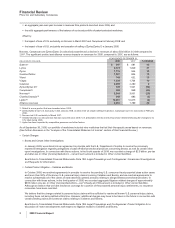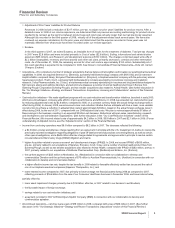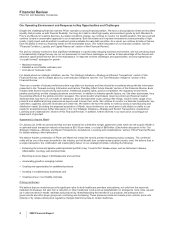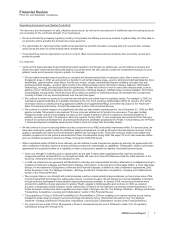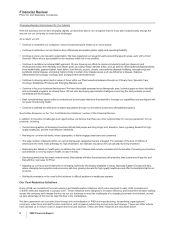Pfizer 2008 Annual Report Download - page 6
Download and view the complete annual report
Please find page 6 of the 2008 Pfizer annual report below. You can navigate through the pages in the report by either clicking on the pages listed below, or by using the keyword search tool below to find specific information within the annual report.
Financial Review
Pfizer Inc and Subsidiary Companies
Our Operating Environment and Response to Key Opportunities and Challenges
Despite the challenging financial markets, Pfizer maintains a strong financial position. We have a strong balance sheet and excellent
liquidity that provides us with financial flexibility. Our long-term debt is rated high quality and investment grade by both Standard &
Poor’s and Moody’s Investors Services. As market conditions change, we continue to monitor our liquidity position. We have and will
continue to take a conservative approach to our investments. Both short-term and long-term investments consist primarily of high-
quality, highly liquid, well-diversified, investment-grade available-for-sale debt securities. As a result, we continue to believe that we
have the ability to meet our financing needs for the foreseeable future. (For further discussion of our financial condition, see the
"Financial Condition, Liquidity and Capital Resources” section of this Financial Review.)
We and our industry continue to face significant challenges in a profoundly changing business environment, and we are taking steps
to fundamentally change the way we run our businesses to meet these challenges, as well as to take advantage of the diverse and
attractive opportunities that we see in the marketplace. In response to these challenges and opportunities, we are progressing on
“our path forward” strategies for growth:
•Maximize revenues;
•Establish a more flexible cost base; and
•Innovate our business model.
For details about our strategic initiatives, see the “Our Strategic Initiatives—Strategy and Recent Transactions” section of this
Financial Review, and for details about our cost-reduction initiatives, see the “Our Cost-Reduction Initiatives” section of this
Financial Review.
There are a number of industry-wide factors that may affect our business and they should be considered along with the information
presented in the “Forward-Looking Information and Factors That May Affect Future Results” section of this Financial Review. Such
industry-wide factors include pricing and access, intellectual property rights, product competition, the regulatory environment,
pipeline productivity and the changing business environment. In addition to industry-specific factors, we, like other businesses, face
the potential effects of the global economic recession. We cannot predict what impacts recent economic and financial market
developments may have on our results of operations. Such developments could, among other things, result in lower usage of our
products and additional pricing pressures as payers seek to lower their costs. We continue to monitor our financial investments, key
customers, suppliers, accounts receivable and credit risk. We believe we have the ability to meet our product manufacturing and
distribution needs. Excluding the proposed acquisition of Wyeth, recent declines in our stock price could inhibit our ability to use
equity for acquisitions (see further discussion in the “Our Strategic Initiatives—Strategy and Recent Transactions: Acquisitions,
Licensing and Collaborations” section of this Financial Review). In addition, further declines in our stock price could trigger an
impairment of goodwill.
Agreement to Acquire Wyeth
On January 26, 2009, we announced that we have entered into a definitive merger agreement under which we will acquire Wyeth in
a cash-and-stock transaction valued on that date at $50.19 per share, or a total of $68 billion. (See further discussion in the “Our
Strategic Initiatives—Strategy and Recent Transactions: Acquisitions, Licensing and Collaborations” section of this Financial Review
for details relating to this transaction.)
We believe that the combination of Pfizer and Wyeth will create the world’s premier biopharmaceutical company. The combined
entity will be one of the most diversified in the industry and will benefit from complementary patient-centric units. We believe that, in
a single transaction, the combination will meaningfully deliver on our strategic priorities, including the following:
•Enhancing the in-line and pipeline patent-protected portfolio in key “Invest to Win” disease areas, such as Alzheimer’s disease,
inflammation, oncology, pain and psychosis;
•Becoming a top-tier player in biotherapeutics and vaccines;
•Accelerating growth in emerging markets;
•Creating new opportunities for established products;
•Investing in complementary businesses; and
•Creating a lower, more flexible cost base.
Pricing and Access
We believe that our medicines provide significant value for both healthcare providers and patients, not only from the improved
treatment of diseases, but also from a reduction in other healthcare costs such as hospitalization or emergency room costs, as well
as in improvements in health, wellness and productivity. Notwithstanding the benefits of our products, the pressures from
governments and other payer groups are continuing and increasing. These pressure points can include price controls, price cuts
(directly or by rebate actions) and regulatory changes that limit access to certain medicines.
4 2008 Financial Report




